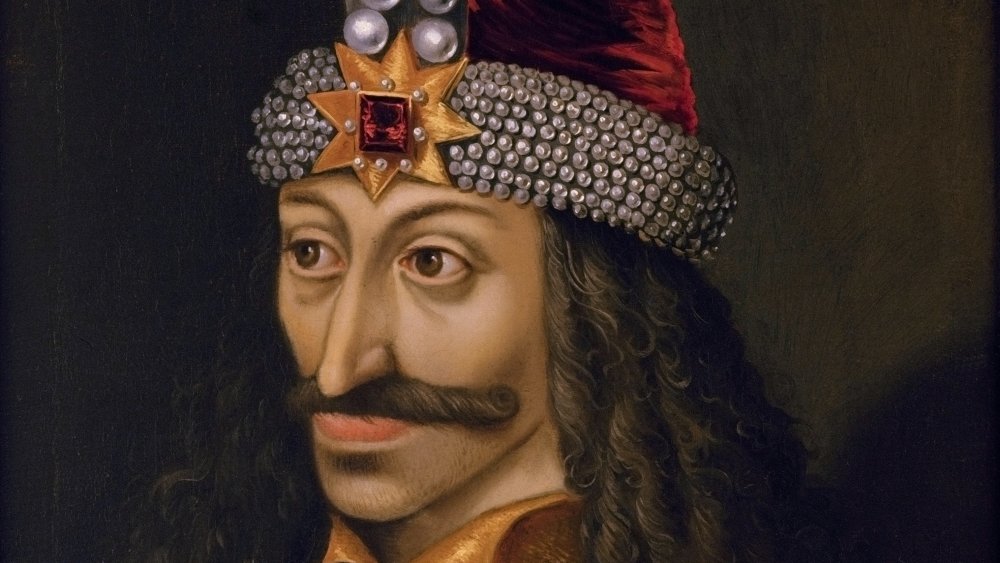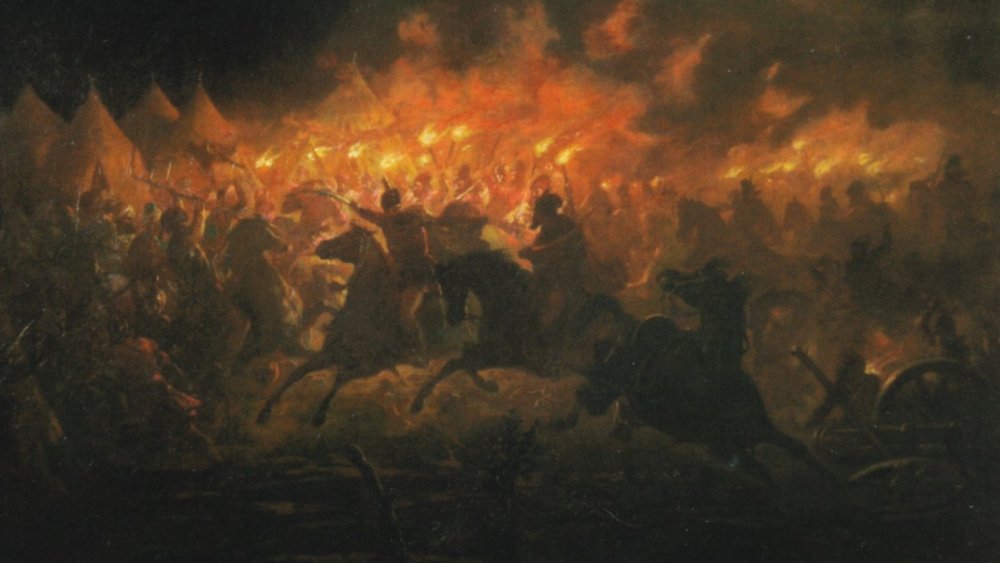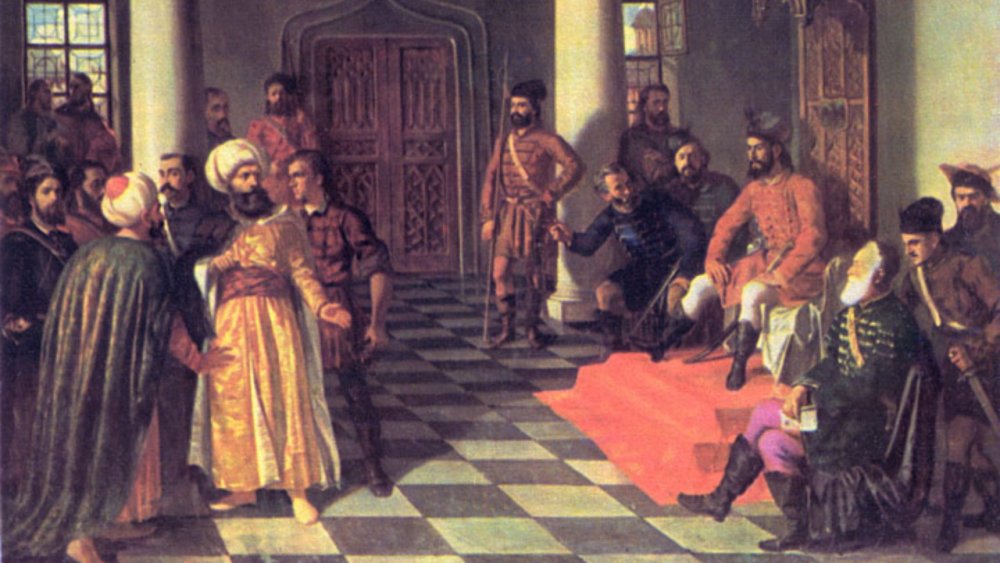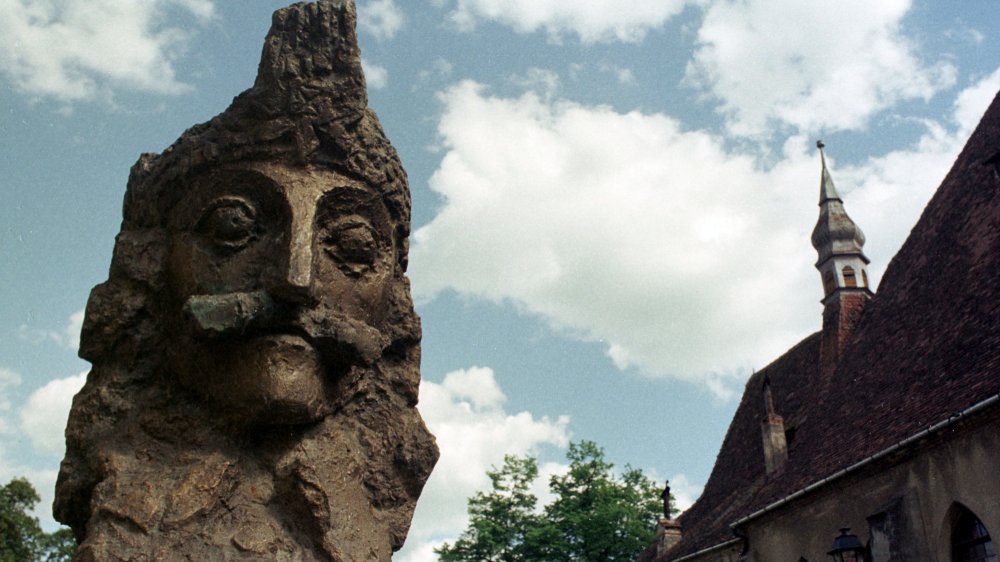The Truth About How Vlad The Impaler Died
Smithsonian writes that 1476, a barrel of honey preserving the severed head of Vlad Dracula — the Impaler, not the vampire — arrived in Ottoman-controlled Constantinople. This grisly delivery, now the trophy of Sultan Mehmed II, would decorate the city gates, per NBC. It was an almost fittingly horrific ending to a tale punctuated by nightmarish violence. Over the course of his life the brutal ruler of Wallachia had killed an estimated 80,000 people, a quarter of which had been impaled on stakes and brandished like flags of flesh outside the city of Targoviste.
According to History, Vlad's victims died in myriad ways, all of them awful. He had them decapitated, skinned, disemboweled, and boiled alive. He was said to have revelled in dining among his so-called "forest" of stake-mounted corpses, purportedly dipping his bread into their dripping blood. Via Live Science, Vlad allegedly nailed turbans to the skulls of Ottoman envoys to display his disdain toward their Muslim faith.
It's worth noting that tales of Vlad's brutality may have been somewhat exaggerated by enemies. And it might surprise you to know that, as Live Science points out, accounts of his literal bloodthirst may have originated with a mistranslation of the claim that he washed his hands in blood, which itself sounds like a metaphor — blood on your hands. But even with these caveats, he likely slaughtered his enemies in exceedingly gory ways. What led to all this ghastly violence and death? It partly started before Vlad was born.
Vlad the avenger and crusader
By the time Vlad the Impaler was born in roughly 1431, the centuries of savage conflict and occasional cannibalism between Christians and Muslims known as the Crusades were dead but not buried. The battles shambled on like war-weary zombies in the form of what History describes as "mainly military campaigns aimed at pushing Muslims from conquered territory, or conquering pagan regions." Vlad belonged to the crusading Order of the Dragon, which formed in 1408 to defend Catholicism against Ottoman Muslims and Orthodox Christians, according to the book The Crusade in the Fifteenth Century. Its leader was future Holy Roman Emperor King Sigismund of Hungary, who inducted Vlad's father, Vlad the Dragon, into the order, per Live Science.
Sigismund focused on beating back the Ottomans, and Vlad the Dragon aided in that effort. However, things became dangerously disordered for the Dragon when he and his sons, Vlad and Radu, attended a diplomatic meeting with Ottoman Sultan Murad II. The trio was seized and Vlad and Radu would remain prisoners for years in exchange for their father's freedom. Experts speculate that years of being used as a bargaining chip gave Vlad a huge chip on his shoulder that helped fuel his decision to attack the Ottomans when he came to power. Sadly, he regained his freedom shortly after losing his father, who was murdered by noblemen while struggling to maintain his rulership of Wallachia.
Vlad's killer in-stake emerges
Vlad the Impaler would gain, lose, and regain his father's seat. For him, the high-stakes nature of the power struggle took on a literal dimension in 1456, when he closed his iron fist around the reins of power and exacted vengeance. Per OZY, Vlad invited the boyars, or local nobility, to a banquet and skewered them like macabre kebabs. He condemned dozens of Saxon merchants to the same torturous demise in 1459 to suppress dissent. He would also set out to gut the Ottoman Empire.
By then, Wallachia had been a vassal state of the Ottomans for over 40 years. Vlad's land maintained limited sovereignty in return for taxes, troops, and fealty. But he evidently thought this arrangement sucked harder than his vampire counterpart. As recounted in A History of the Crusades, in 1459, Pope Pius II declared a crusade against the Ottomans, who conquered Constantinople in 1453. Vlad the Impaler would answer the call. In 1462, Sultan Mehmet II made a call of his own, dispatching envoys to make sure Vlad stayed a vassal. But Vlad dispatched them with impalement. In case that didn't get the point across, he also stopped paying taxes.
Vlad the Impaler employed psychotic warfare
Vlad embraced unbridled barbarism when battling the Ottomans. As OZY describes, some of the tried and truly horrifying tactics he used included sending men infected with bubonic plague to mingle with Ottoman troops, poisoning wells, and conducting night raids. In 1462, he had an unimaginable 20,000 Ottoman corpses placed on stakes in an act of warfare that sounds more psychotic than psychological. OZY writes, "The tallest spike was reserved for the sultan's general, still ceremoniously robed."
Per History, a "horrified" Mehmed fled to Constantinople when he encountered the mass aerial grave serving as grisly bird feed for crows. Vlad would taste victory, escape capture by the Ottomans, survive imprisonment by Hungarian enemies, and reclaim his crown. But the Ottoman onslaught didn't stop. In 1476, he finally found himself in over his head on the battlefield. When it was over he no longer had a head at all.



